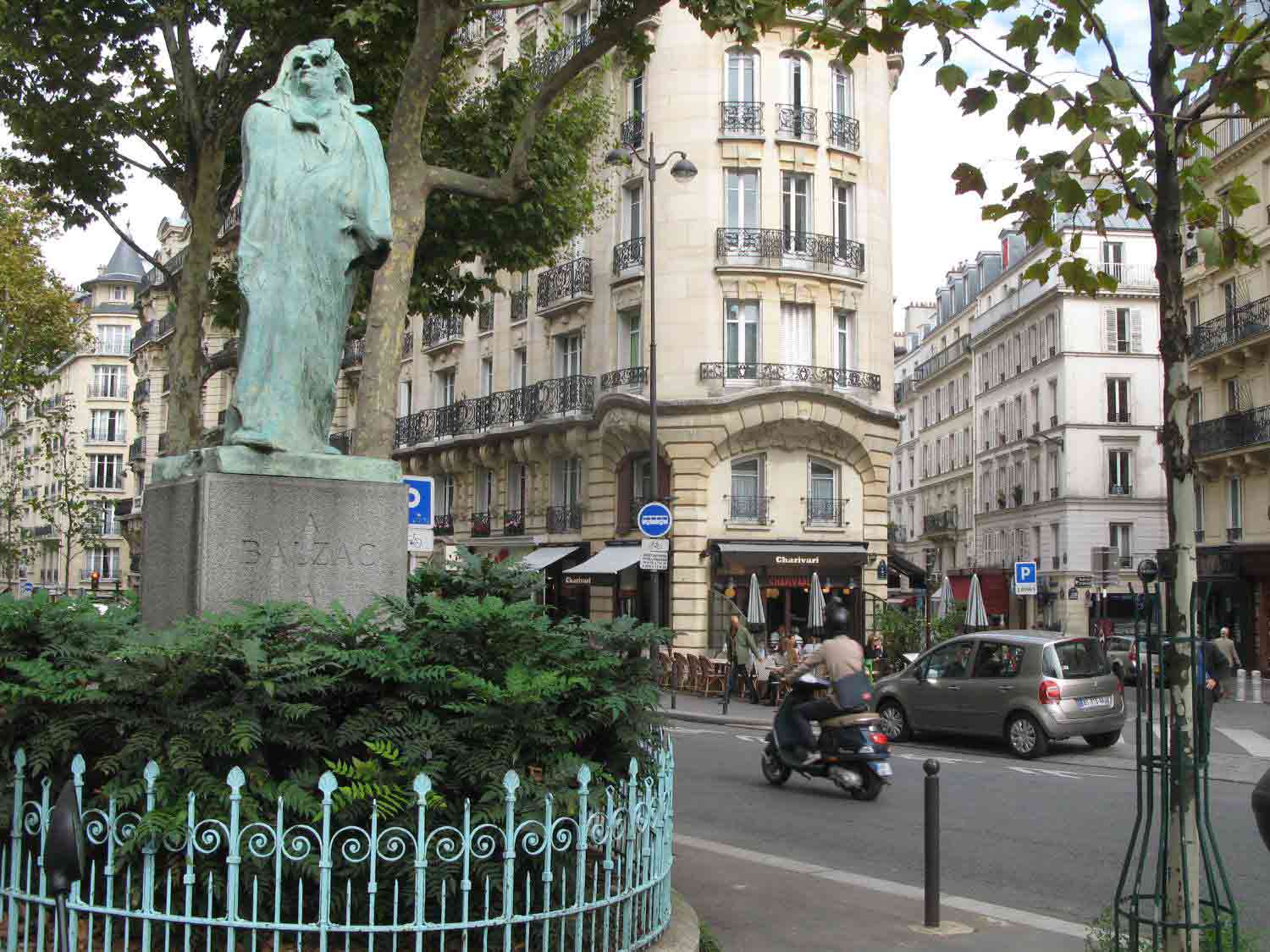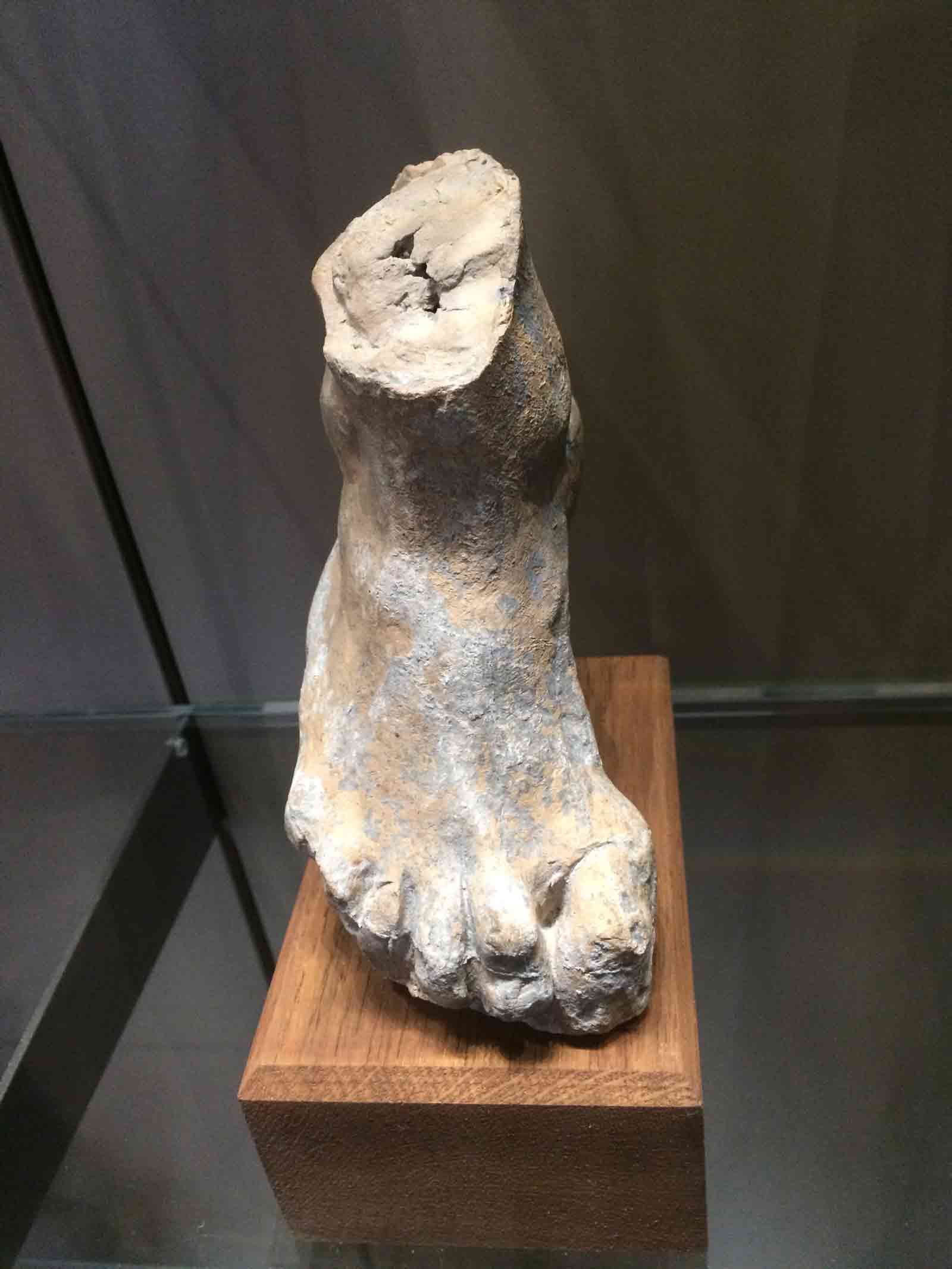The Thinker is not my favorite Rodin sculpture. That would be his Monument to Balzac, the looming embodiment of the coffee-fueled visionary enfolded in his dressing robe and “foaming with creation,” as the German literary scholar Ernst Robert Curtius described him. If you happen upon the statue at the intersection of the Boulevards du Montparnasse and Raspail, backlit against the Parisian sky, the effect can be overwhelming. The commissioned tribute to Balzac was met with outrage when it was first exhibited in 1898; it was considered not just disrespectful but indecent. (What would its critics have said if they knew Rodin had made earlier sculptures of Balzac buck-naked, including one in which he grasps his penis?) In fact, Rodin’s monument displayed the most profound respect. His Balzac—and of how many monuments to writers can this be said?—makes one want to read Balzac.
The Thinker is different. The best-known of Rodin’s works, it is probably the most familiar modern sculpture in the world. It has been reproduced, parodied, miniaturized, magnified, to the point that it’s difficult to see it, to take it in. It’s a meme, a cliché, a visual punchline. Ask teenagers to think and they will assume the pose of The Thinker. “One sees them contracting their brows, holding their breath, stiffening their muscles,” Simone Weil wrote of her students. “If after two minutes they are asked what they have been paying attention to they cannot reply.”
At the renovated Musée Rodin in Paris, much of one spacious, light-filled room is devoted to the evolution of The Thinker. We see how it began as a small figure—probably one of the first conceived—in Rodin’s monumental and never-completed project The Gates of Hell. “Before the door, seated on a rock, Dante thinking of the plan of his poem,” Rodin wrote. In an early version of the sculpture, cast in bronze in 1880, The Thinker wears the tight-fitting cap with earflaps that one finds in Giotto’s fresco of Dante. Both The Thinker and Balzac began as representations of literary fecundity, the creators, respectively, of The Divine Comedy and La Comédie Humaine.
And yet, The Thinker—who, in the final version, retains a vestigial earflap—doesn’t really look like a writer. Though modeled on an actual, muscular middle-aged man, the sculpture, at first glance, feels idealized, anchored in the nineteenth century even as Balzac, with his meaty, rough-modeled, galvanized features, strides into the twentieth. The Thinker is the kind of image that inspired the Swiss writer Robert Walser, walking among the misshapen humanity on display in the marketplace in Berlin, to observe, “God is the opposite of Rodin.” For me, The Thinker, which Rodin chose as his grave marker, was just another comely statue in the garden, as Munch’s lovely painting depicts it (also at the Musée Rodin), and not the heroic beacon—the Ayn Rand version—that Steichen spotlighted in his over-the-top portrait of Rodin contemplating his famous statue.
But then something brought me closer to The Thinker. In a glass case at the Musée Rodin, displaying preparatory studies, my attention settled on a terra-cotta fragment identified as “The Thinker’s Right Foot.” His foot! Suddenly, I had a completely different feel for The Thinker. And I found myself wondering whether Rodin, too, had felt that the success of the sculpture might depend in some crucial way on getting the feet right. In one of his two major statements on The Thinker, when he recalled moving from his original concept of Dante in earflaps to something more universal, Rodin wrote: “I conceived another thinker, a naked man; seated upon a rock, his feet drawn under him, his fist against his teeth, he dreams.” The sequence here—the rock, the feet, the fist, the teeth, the dream—implies that thinking, as Rodin conceived of it, emerges from the feet and moves upward and inward. I looked carefully at the Thinker’s right foot, how the big toe slides under the adjacent, sheltering toe to get a better grip.
I half-remembered an essay Georges Bataille wrote on “The Big Toe,” in which he noted that man, “though the most noble of animals… has feet, and these feet independently lead an ignoble life.” Bataille touches here on what one might call the cultural history of feet. Feet are base; they are in touch with dirt, everything that humans, in their vanity, wish to rise above. It is a gesture of self-abasement when Jesus, after the Passover meal in the Gospel of John, dresses as a servant and washes his disciples’ feet. Jesus’s own pierced feet became part of Christian iconography, nowhere more powerfully than in Mantegna’s radically foreshortened, feet-first The Dead Christ.
Advertisement
And yet, there’s nothing ignoble about Rodin’s foot. It is fully alive, like Daniel Day-Lewis’s creative appendage in My Left Foot—in the film both an assertion of artistic integrity against all odds as well as a likely defiant echo of the derogatory Ulster term for Catholics, “left-footers,” those who pushed on their spades with their left feet when digging the fields. Why, then, are the Thinker’s feet, as Rodin specifies, “drawn under him”? Because they are grasping the rock. This thinker is thinking with his feet as well as his head. “And the man sitting,” as Rilke observed in his beautiful little book on Rodin, is “thinking with his whole body.” As I look at him now, Rodin’s thinker looks like an eagle perched on a rock, his talons firmly grasping the stone, ready to pounce. There is in Rodin’s right foot, as Michael Fried writes of one of the Prussian painter Adolf Menzel’s wondrous portraits of his own foot, “an awareness of the foot as a locus of feeling both of itself and the world, the two being indissolubly mixed or ‘interwoven’ in a way that is entirely familiar to us in ordinary life but that drawing or painting only rarely seeks to convey.” Of course, some people (ballet dancers, soccer players) experience life more vividly through their feet than others do, though they may pay a price for it later, as the battered, bulbous condition of Mikhail Baryshnikov’s feet reveals in an Annie Leibovitz ad shoot.
Rodin recognized a political message in his Thinker’s rootedness to the ground. The day before an enlarged version was placed in front of the Panthéon in Paris, during a period of social strife, in 1906, Rodin proclaimed that The Thinker was a symbol of the French worker, magnifying, as he put it, “the fertile thought of those humble people of the soil.” It seems doubtful that whoever placed a bomb under the pedestal of another bronze cast of The Thinker, in Cleveland, in the early hours of March 24, 1970, was trying to strike a blow against the “humble people of the soil.” More likely the bomb was meant to be an attack on Western civilization, as embodied in the emblematic symbol of the male, cerebral, out-of-touch thinker. If so, I believe that the Cleveland bomber—never apprehended—misunderstood the sculpture. Rodin himself rejected the idea of the idealized thinker with his head in the clouds rather than his feet in the dirt.
In a classic essay, the art historian Leo Steinberg noted how Rodin welcomed accidents into his working methods. When the plaster bust of his first great sculpture, The Man with the Broken Nose (circa 1863), froze and the back of the head fell off, Rodin exhibited it as a mask instead. “He is the first whose sculpture deliberately harnessed the forces of accident,” Steinberg wrote of Rodin’s “partnership with disaster and chance.” By a strange irony, as though deliberately targeting the true source of power in the sculpture, the bomb blast on that early March morning in Cleveland blew the feet clean off The Thinker. A strangely powerful figure in its own right, the footloose Thinker, which remains on view in Cleveland, has never been repaired. But his original version of the right foot, meanwhile, is safe in Paris.





